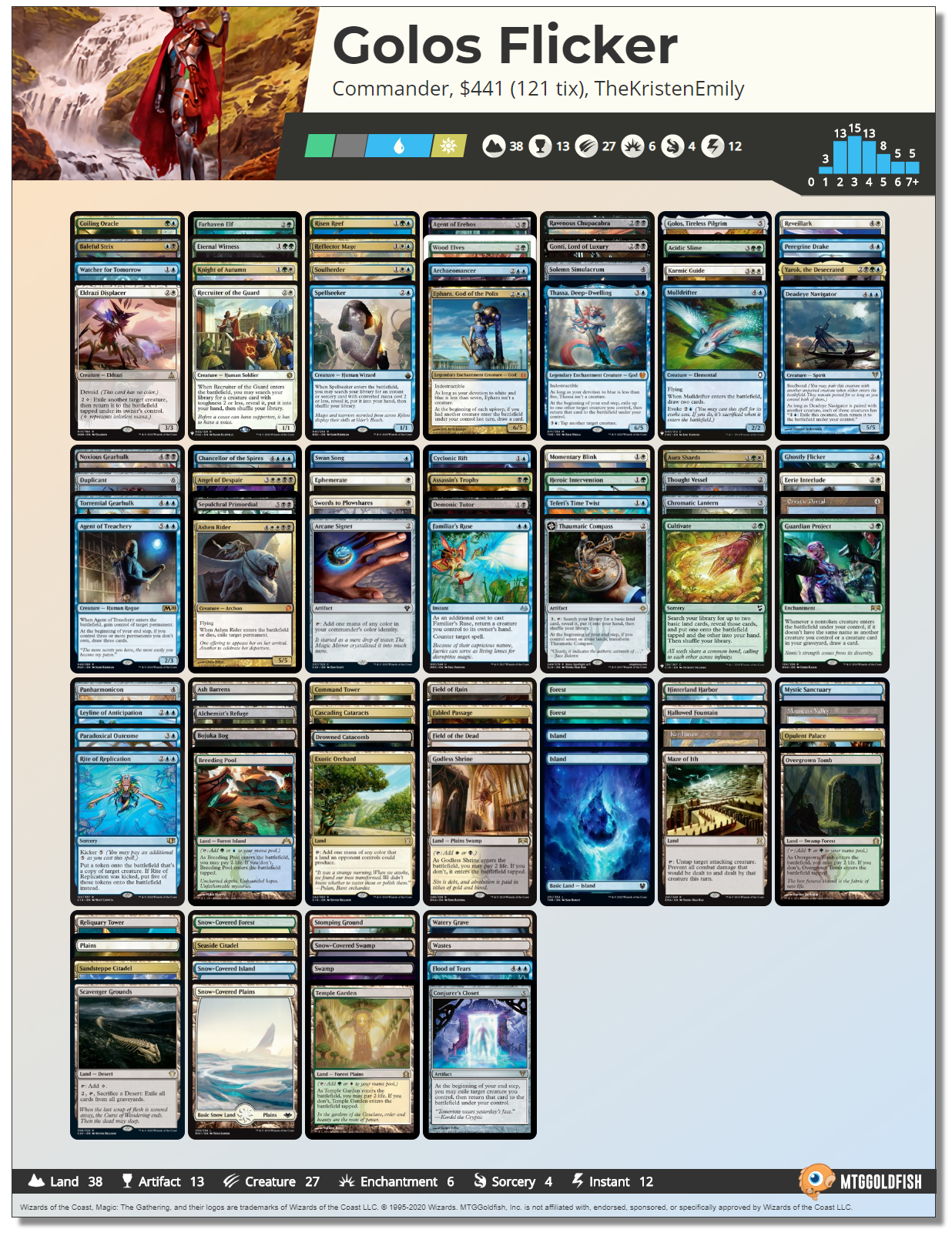Kristen takes us on a pilgrimage with Golos Flicker, a fun to pilot EDH deck looking to revisit the classic Deadeye Navigator blink strategy helmed by Golos, Tireless Pilgrim.
Let me say this up front: I think the ease of building four and five color Commander decks is overall a net negative to the format. Whilst I can see the value in printing cool five color Commanders that let people unite tribes, or fix their mana/draw in the case of Golos, Tireless Pilgrim, or Niv-Mizzet Reborn, they’re too easy to build without enough of a drawback. Sure, newer players can dump their trade binder into a deck and have a semi-playable pile, but at what cost? The drawbacks just aren’t there.
The existence of fetchlands aside—they also contribute to streamlining strategies—these Commanders are very consistent and allow you to forgo any weaknesses of playing two or three color decks. If you’ve ever played against five color Niv, you’ll know how it is—they have an answer to everything, and enough recursion, that the guild pair restriction doesn’t feel like a restriction at all.
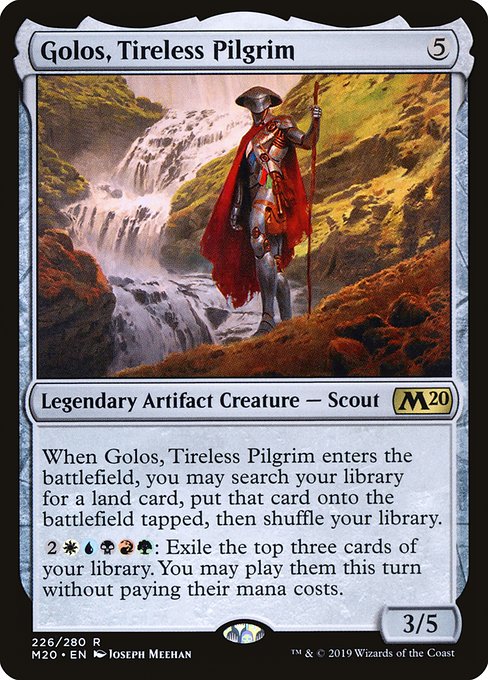
Golos, however, is on a whole other level. It has no mana restriction to cast, and can fix your mana and ramp you from the Command Zone. That’s not even getting into the power of the activated ability; ramping and cheating spells into play is very strong, and in many ways the fact that Golos is the perfect Mono-white Commander says it all. What’s not to love about ramp and cheating mana in Mono-white? You can play Chromatic Lantern or grab Cascading Cataracts and peel your Elesh Norns and Avacyns off the top!
For me, part of the magic and enjoyment in Commander is building to restrictions, whether they be theme, tribe, or mechanic. So yeah—these new style Commanders that allow you to ignore those kinds of restrictions and play good stuff? Really not for me. That said, I did have a lot of fun building Golos Flicker, and I can see the appeal of playing this not-so-sad robot.
A Tireless Pilgrimage
There were two events that led me to building a Golos Flicker deck.
The first was building and piloting Yarok, the Desecrated. That deck came about partially as a challenge: my friends are constantly winding me up about playing too much Boros—despite only 3/15 of my paper Commander decks being Boros! Additionally, I built Yarok to make a point. Many of the newer players in my social circle hadn’t yet cottoned on to just how easy and obnoxious Sultai value piles could be, and I wanted to demonstrate what they’re like to play against, in the hopes of helping us all make more sociable deck choices for appropriate tables. One miserable three-hour slugfest later, both I and them were done with Yarok.
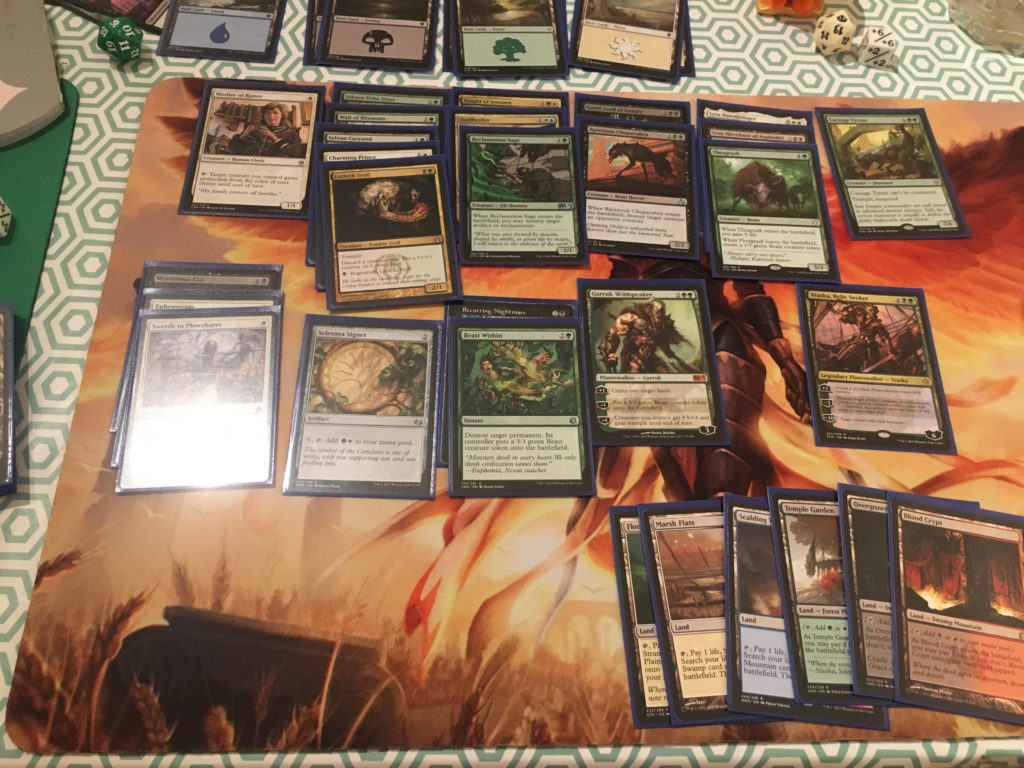
The second was drafting an accidental archetype in my friend’s cube, a sort of four-color flicker/reanimator pile. It was a bit of a trainwreck of a draft that started strong with Recurring Nightmare; after pushing ahead despite feeling like Blue and Green were being cut, I ended up with a pretty mediocre set of cards. I looked at all of the White cards I was taking on the wheel—White looked to be underdrafted—and decided to switch gears and try and jam as many colors together as could feasibly work. I was rewarded for taking a signet and fetches early, and ended up piloting the deck to a 3-0 win. The highlight had to be the game in which I cast Sneak Attack off Gonti, Lord of Luxury, then fetched up the Blood Crypt I needed to activate it, winning me the game.
Sadly, Recurring Nightmare isn’t legal in Commander, so I couldn’t recreate my dream. I did, however, leave with some inspiration.
Golos Flicker
With the remains of a Yarok deck to pick through, and a healthy appreciation for what White could bring to the table, I sat down to start brewing. None of the Bant Commanders, such as Roon of the Hidden Realm, interested me much. I also didn’t really feel like building a Partner deck, and so I arrived at the conclusion that Golos would fit perfectly. It let me play as many colors as I wanted, and could be flickered for value.
There was also the matter of my landbase. I could easily shove my spare shocklands into the deck, but I was woefully short of fetchlands. With the ramp options in the deck, I could hopefully get around this obstacle and enjoy playing four colors.
The deck is a flicker deck that takes the best enters-the-battlefield effects from each color to build a rolling value engine that is hard to stop. Ramping and blinking our value bodies to gain incremental value and avoid removal is the aim, and our velocity hopes to take us toward a finish in which we either completely out-value our opponents or combo off. If we can’t swing for the win with value from Sepulchral Primordial, Gonti, Lord of Luxury, Chancellor of the Spires, or a kicked Rite of Replication; we can dust off the classic Deadeye Navigator plus Peregrine Drake combo for infinite mana, then infinite Golos activations to dig for Angel of Despair, Ashen Rider, or Acidic Slime.
The combo works by stacking the “Untap Five Lands” trigger from Peregrine Drake. We’re only spending 1U to activate Deadeye Navigator to flicker the Drake, so we end up mana positive every time we perform the loop. Once we have infinite mana of whatever colors our lands can produce, we can keep flickering one of the aforementioned creatures to either steal or remove opponent’s boards. The end game is stripping our opponents of every permanent they have in play.
The Manabase
Lands tend to be more of a bonus utility, serving as the “stock” to stir the ingredients in; for that reason, I usually visit them last in my articles. Golos Flicker is different, though, and so it’s useful to upgrade that stock into a rich broth of versatility. Let’s build up some flavor.
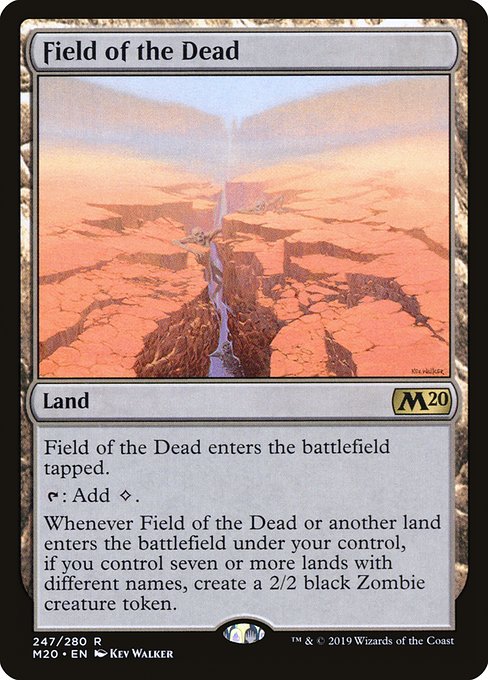
The first consideration is to season, and the salt in this deck is very much the infamous lieutenant to any Golos deck: Field of the Dead. It’s probably more ubiquitous than Golos itself, and a land that most decks could run. For flavor reasons, I tend to avoid it in a lot of builds; but we’re about value here, so it’s a snap include. Field loves Fetchlands, and the best I could come up with is Fabled Passage and Mountain Valley. Of course, if you have more, go for it. I’d say that for a deck this hungry on mana, though, that you may want to go up to 39 or more lands in that case—one of our 38 is Maze of Ith, which doesn’t tap for mana.
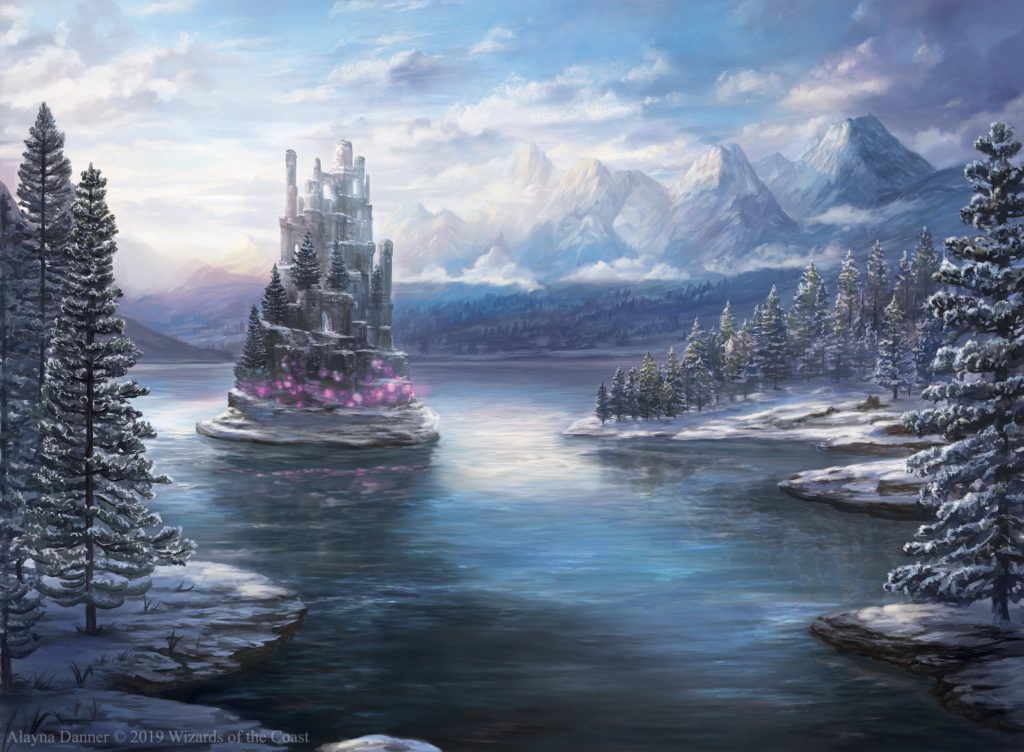
Snow-Covered Island by Alayna Danner. Digital.
I’m choosing to forgo red here, as I don’t think we’ll miss it. I made the conscious decision to play every Forest-based shockland to help fixing with Wood Elves. Cascading Cataracts is our main way to activate Golos; beyond the rocks which allow us to do it, we have up to four red sources if Exotic Orchard is online. To enable Field of the Dead, we’re firmly split between snow basics and normal basics, with the only duplicates being a Forest and an Island. We’re playing Wastes for a fetchable colorless source that turns on Eldrazi Displacer.
Playing Golos allows us to select from a toolbox of utility lands. We can’t run too many due to the hungry mana requirements of a four-five color deck, but I’ve included:
Field of the Dead
Scavenger Grounds
Maze of Ith
Kor Haven
Reliquary Tower
Alchemist’s Refuge (plus Leyline of Anticipation!)
Field of Ruin
Bojuka Bog
These all answer various problems or help us gain advantage. I like Field of Ruin here over Ghost Quarter, as the extra landfall trigger is a bonus. Having both Maze of Ith and Kor Haven, alongside Spires of Orazca (flipped Thaumatic Compass) means we’re pretty good at avoiding attacks while we build to our finish.
Teferi, Let’s Twist Again
No good Golos flicker deck would be complete without a package of ways to blink permanents. New Pauper all-star Ephemerate joins Momentary Blink, Teferi’s Time Twist, Eerie Interlude, and Ghostly Flicker. Historically, repeatable blink has been hard to come by, with only Conjurer’s Closet and cards like Brago, King Eternal offering repeatable value.
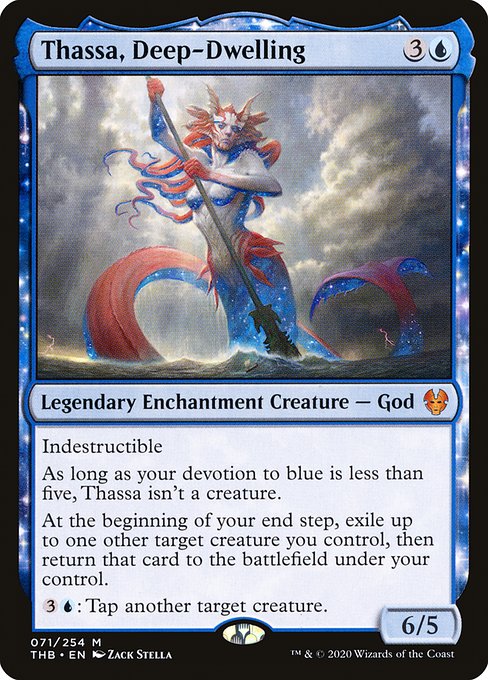
Thanks to recent printings of Soulherder and Thassa, Deep-Dwelling, however, we have even more free ways to flicker our creatures turn after turn. Alongside them, we’re running Eldrazi Displacer for repeatable activations; and Erratic Portal, which can double as a way to bounce opponent’s creatures if they’re hurting for mana.
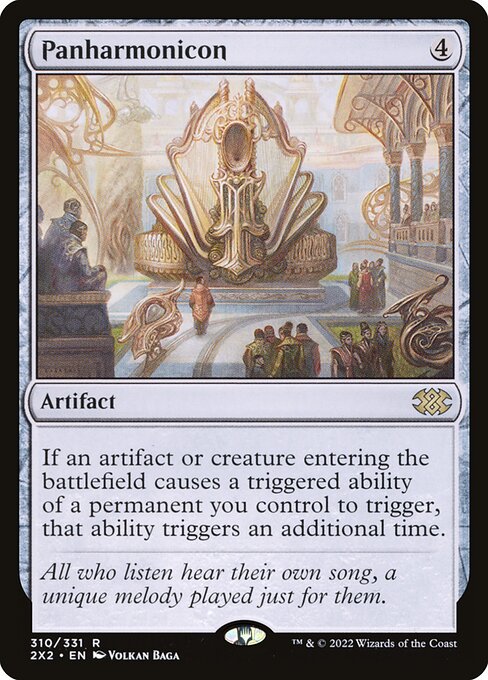
Getting value from triggers is great, but getting double helpings is even better. For that reason, Yarok, the Desecrated and Panharmonicon are both ported over from the Sultai build. With all of the comings and goings, we can draw extra cards from Ephara, God of the Polis and Guardian Project, while Aura Shards ensures our opponents find it impossible to get set up.
Alongside Aura Shards, Knight of Autumn and Acidic Slime can deal with artifacts and enchantments. If creatures are an issue, we have Noxious Gearhulk, Ravenous Chupacabra, Duplicant, and Reflector Mage. Agent of Erebos deals with graveyards, and Ashen Rider and Angel of Despair swiftly end any permanent that looks at us the wrong way. If everything is getting a little too much, we can always run out Flood of Tears to reset the board, or Cylonic Rift if needed.
Seeking Spells
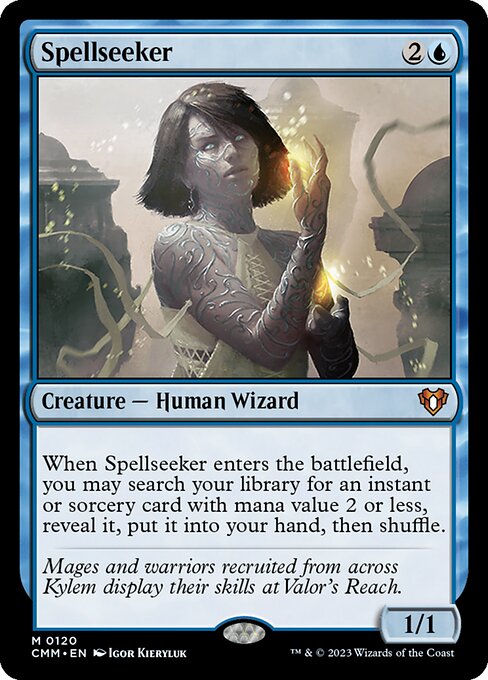
Spellseeker is perhaps the most useful creature in the deck. We have a suite of spells to grab from it, not limited to the flicker spells previously mentioned—or Cyclonic Rift! Assassin’s Trophy and Swords to Plowshares are versatile removal, Familiar’s Ruse and Swan Song are great counterspells, Heroic Intervention protects our board, and Demonic Tutor can dig for our win conditions. I usually like to grab Ephemerate first, as the rebound clause means we get to search for an additional two spells provided Spellseeker resolves and sticks.
Of course, casting any of these spells once is good, but to lean into greatness we need recursion. Reveillark and Karmic Guide provide great recursion of creatures, but things get spicier with Eternal Witness and Archaeomancer, who let us buy back basically whatever we want. Torrential Gearhulk is another nice body to end games with that provides repeatable flicker value, too.
The Value Engine

Mulldrifter by Eric Fortune
None of this is possible without the main value engine behind the deck; and as we’re in Blue and Green, expect oodles of value. From classic plays like Mulldrifter, Baleful Strix, Recruiter of the Guard, and Coiling Oracle; to newcomers Watcher for Tomorrow, Risen Reef, and Paradoxical Outcome; there’s plenty of ways to ramp and draw cards. Thought Vessel and Thaumatic Compass are nice ramp pieces that double as redundancy for Reliquary Tower and Maze of Ith; Arcane Signet and Chromatic Lantern fix us to allow for Golos activations. The real stars of the deck are probably Wood Elves and Farhaven Elf, though—we wouldn’t get very far without them.
Adapting to Webcam EDH
I really love this Golos Flicker deck, mainly because mechanically it feels fun and distinct from my other decks I have built. The goal was to make it “not another Golos deck.” Whilst I’ve hit some of those notes, like in the manabase, I have tried to direct my card choices toward a mechanical theme. I deliberately went low on combo and high on “variant value” as I like to call it. The problem with variant value these days is that we play most of our games of EDH over webcam! This means cards that use or draw an opponent’s cards are a little difficult to resolve; for the good of the play experience for all parties, subbing them out of the deck is wise.
For that reason, I’ve made a few changes for the current metagame. Out are Chancellor of the Spires, Sepulchral Primordial, Gonti, Lord of Luxury, and Agent of Treachery. In their place, I’ve opted to improve the consistency of the deck—both to be cognizant of time, and to adapt to the admittedly higher power level of games I’ve been having. I’ve added Uro, Titan of Nature’s Wrath and Cloudblazer to accelerate our value engine with more redundancy; Gray Merchant of Asphodel as another win condition, in case my others are exiled; and Palinchron, as another way to go infinite. Many people would have probably made these adjustments from the offset, but as I say: I enjoy a little more variance and splashy plays at my tables.
So, what do you think of Golos Flicker? How have you managed to keep Golos exciting? Let me know on Twitter to continue the discussion.
Based in the UK, Kristen is a lover of both Limited and Commander, and can most often be found championing the Boros Legion when called upon to sit down and shuffle up.


